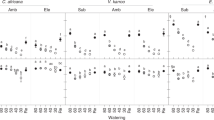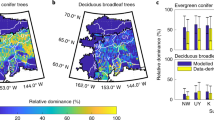Abstract
Global circulation models and empirical evidence suggest that precipitation events are likely to become more extreme across much of the globe1,2. As most plant roots are in shallow soils3,4,5, small but pervasive changes in precipitation intensity could be expected to cause large-scale shifts in plant growth, yet experimental tests of the effects of precipitation intensity are lacking6,7,8,9. Here we show that, without changing the total amount of precipitation, small experimental increases in precipitation intensity can push soil water deeper into the soil, increase aboveground woody plant growth and decrease aboveground grass growth in a savannah system. These responses seemed to reflect the ability of woody plants to increase their rooting depths and competitively suppress grass growth. In many parts of the world, woody plant abundance has multiplied in the past 50–100 years, causing changes in fire, forage value, biodiversity and carbon cycling10. Factors such as fire, grazing and atmospheric CO2 concentrations have become dominant explanations for this woody encroachment and semi-arid structure in general10,11,12. Our results suggest that niche partitioning is also an important factor in tree–grass coexistence and that the woody plant encroachment observed over the past century may continue in the future should precipitation intensity increase.
This is a preview of subscription content, access via your institution
Access options
Subscribe to this journal
Receive 12 print issues and online access
$209.00 per year
only $17.42 per issue
Buy this article
- Purchase on Springer Link
- Instant access to full article PDF
Prices may be subject to local taxes which are calculated during checkout





Similar content being viewed by others
References
Easterling, D. et al. Climate extremes: Observations, modeling, and impacts. Science 289, 2068–2074 (2000).
Frich, P. et al. Observed coherent changes in climatic extremes during the second half of the twentieth century. Clim. Res. 19, 193–212 (2002).
Schenk, H. J. & Jackson, R. B. Rooting depths, lateral root spreads and below-ground/aboveground allometries of plants in water-limited ecosystems. J. Ecol. 90, 480–494 (2002).
Kulmatiski, A. & Beard, K. H. Root niche partitioning among grasses, saplings, and trees measured using a tracer technique. Oecologia 171, 25–37 (2013).
Kulmatiski, A., Beard, K. H., Verweij, R. J. T. & February, E. C. A depth-controlled tracer technique measures vertical, horizontal and temporal patterns of water use by trees and grasses in a subtropical savanna. New Phytol. 188, 199–209 (2010).
Beier, C. et al. Precipitation manipulation experiments—challenges and recommendations for the future. Ecol. Lett. 15, 899–911 (2012).
Reyer, C. et al. A plant’s perspective of extremes: Terrestrial plant responses to changing climatic variability. Glob. Change Biol. 19, 75–89 (2013).
Knapp, A. K. et al. Consequences of more extreme precipitation regimes for terrestrial ecosystems. Bioscience 58, 811–821 (2008).
Porporato, A., Daly, E. & Rodriguez-Iturbe, I. Soil water balance and ecosystem response to climate change. Am. Nat. 164, 625–632 (2004).
Eldridge, D. J. et al. Impacts of shrub encroachment on ecosystem structure and functioning: Towards a global synthesis. Ecol. Lett. 14, 709–722 (2011).
Buitenwerf, R., Bond, W. J., Stevens, N. & Trollope, W. S. W. Increased tree densities in South African savannas: >50years of data suggests CO2 as a driver. Glob. Change Biol. 18, 675–684 (2012).
Wigley, B. J., Bond, W. J. & Hoffman, M. T. Thicket expansion in a South African savanna under divergent land use: Local versus global drivers? Glob. Change Biol. 16, 964–976 (2010).
Grace, J., José, J. S., Meir, P., Miranda, H. S. & Montes, R. A. Productivity and carbon fluxes of tropical savannas. J. Biogeogr. 33, 387–400 (2006).
Wu, Z., Dijkstra, P., Koch, G. W., Pañuelas, J. & Hungate, B. A. Responses of terrestrial ecosystems to temperature and precipitation change: A meta-analysis of experimental manipulation. Glob. Change Biol. 17, 927–942 (2011).
Knapp, A. K. et al. Rainfall variability, carbon cycling, and plant species diversity in a mesic grassland. Science 298, 2202–2205 (2002).
Good, S. P. & Caylor, K. K. Climatological determinants of woody cover in Africa. Proc. Natl Acad. Sci. USA 108, 4902–4907 (2011).
Scheiter, S. & Higgins, S. I. Partitioning of root and shoot competition. Am. Nat. 170, 587–601 (2007).
Walker, B. H. & Noy-Meir, I. in Tropical Savannas (eds Huntley, B. J & Walker, B. H.) 556–590 (Springer, 1982).
Sala, O. E., Lauenroth, W. K. & Parton, W. J. Long-term soil water dynamics in the shortgrass steppe. Ecology 73, 1175–1181 (1992).
Heisler-White, J. L., Blair, J. M., Kelly, E. F., Harmoney, K. & Knapp, A. K. Contingent productivity responses to more extreme rainfall regimes across a grassland biome. Glob. Change Biol. 15, 2894–2904 (2009).
February, E. C. & Higgins, S. I. The distribution of tree and grass roots in savannas in relation to soil nitrogen and water. South Afr. J. Bot. 76, 517–523 (2010).
February, E. C., Higgins, S. I., Bond, W. J. & Swemmer, L. Influence of competition and rainfall manipulation on the growth responses of savanna trees and grasses. Ecology (in the press).
Fay, P. A. et al. Relative effects of precipitation variability and warming on tallgrass prairie ecosystem function. Biogeosciences 8, 3053–3068 (2011).
Nippert, J. B., Knapp, A. K. & Briggs, J. M. Intra-annual rainfall variability and grassland productivity: Can the past predict the future? Plant Ecol. 184, 65–74 (2006).
Walter, J. et al. Increased rainfall variability reduces biomass and forage quality of temperate grassland largely independent of mowing frequency. Agr. Ecosyst. Environ. 148, 1–10 (2012).
Laporte, M., Duchesne, L. & Wetzel, S. Effect of rainfall patterns on soil surface CO2 efflux, soil moisture, soil temperature and plant growth in a grassland ecosystem of northern Ontario, Canada: Implications for climate change. BMC Ecology 2, 10 (2002).
Fay, P. A., Carlisle, J. D., Knapp, A. K., Blair, J. M. & Collins, S. L. Productivity responses to altered rainfall patterns in a C-4-dominated grassland. Oecologia 137, 245–251 (2003).
Venter, F. J., Scholes, R. J. & Eckhardt, H. C. in The Kruger Experience (eds du Toit, J., Rogers, K. & Biggs, H.) 83–129 (Island Press, 2003).
Zambatis, N., Zacharias, P. J. K., Morris, C. D. & Derry, J. F. Re-evaluation of the disc pasture meter calibration for the Kruger National Park. Afr. J. Range For. Sci. 23, 85–97 (2006).
Hendricks, J. J. et al. Assessing the patterns and controls of fine root dynamics: An empirical test and methodological review. J. Ecol. 94, 40–57 (2006).
Acknowledgements
We thank the Andrew Mellon Foundation, Alaska EPSCOR and the University of Alaska Anchorage’s Environment and Natural Resources Institute for financial support, South African National Parks for allowing us to do this research in Kruger, and E. February, W. Bond and the University of Cape Town for the shelters. Field managers: M. Cooper, M. Mazzacavallo, M. Keretetsi, S. Heath and L. Hierl. Field/laboratory assistants: W. Sibuye, R. Mashele, V. Sibuye and M. Rogers. Statistical advice: S. Durham. Experiments complied with the present laws of the Republic of South Africa. This research was supported by the Utah Agricultural Experiment Station, Utah State University, and approved as journal paper number 8538.
Author information
Authors and Affiliations
Contributions
A.K. and K.H.B conceived the research, oversaw measurements, analysed data and contributed to the preparation of the manuscript.
Corresponding author
Ethics declarations
Competing interests
The authors declare no competing financial interests.
Supplementary information
Rights and permissions
About this article
Cite this article
Kulmatiski, A., Beard, K. Woody plant encroachment facilitated by increased precipitation intensity. Nature Clim Change 3, 833–837 (2013). https://doi.org/10.1038/nclimate1904
Received:
Accepted:
Published:
Issue Date:
DOI: https://doi.org/10.1038/nclimate1904
This article is cited by
-
Is woody plant encroachment bad? Benefits of woody plant encroachment—A review
Landscape Ecology (2024)
-
Precipitation Intensification Increases Shrub Dominance in Arid, Not Mesic, Ecosystems
Ecosystems (2023)
-
Assessing the future global distribution of land ecosystems as determined by climate change and cropland incursion
Climatic Change (2023)
-
Vegetation drought risk assessment based on the multi-weight methods in Northwest China
Environmental Monitoring and Assessment (2023)
-
Precipitation and plant functional composition mediate desert canopy nutrient responses to water and nitrogen addition
Plant and Soil (2023)



